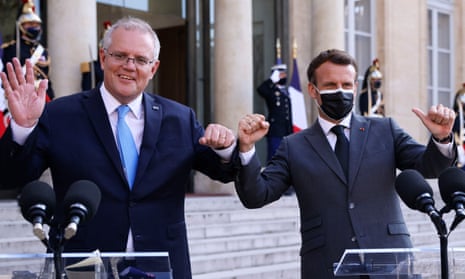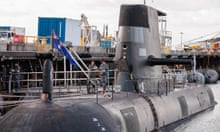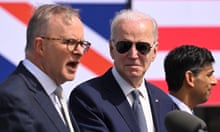Just two weeks before France complained of being “stabbed in the back”, two senior French ministers met with their Australian counterparts, Marise Payne and Peter Dutton, for what was meant to be a sign of ever-strengthening ties between the two countries.
The joint statement they issued now seems extraordinary, given the events that followed. “Both sides committed to deepen defence industry cooperation and enhance their capability edge in the region,” they said. “Ministers underlined the importance of the future submarine program.”
That meeting – now central to claims France was blindsided by what the Biden administration called “the biggest strategic step that Australia has taken in generations” – occurred by video conference on 30 August.
Then on 15 September the Australian government formally notified the French government – just hours before the official announcement coordinated with Washington and London – that it was tearing up the $90bn contract with France’s Naval Group in favour of a new arrangement with the US and the UK to acquire nuclear-powered submarines.
“We had established a relationship of trust with Australia – this trust has been betrayed,” said the French foreign minister, Jean-Yves Le Drian, who had been part of those apparently optimistic talks with Dutton and Payne two weeks earlier.
So how did Australia’s largest ever defence acquisition go so badly off course? And what was France doing behind the scenes to reassure Australia to stick with the project?
There must be something in the water
To understand the French anger, we need to rewind a few years. Australia is no stranger to debacles over submarine programs – it seems to be the default.
France is the second close partner of Australia to be burnt by the government’s approach to finding a replacement for the ageing Collins-class submarines.
Tony Abbott had a close working relationship with the Japanese prime minister, Shinzo Abe, and was known to be keen on Japan building Australia’s future submarine fleet.
But South Australian Liberal MPs were worried about shipbuilding jobs in that state, and raised the issue during internal discussions before Abbott faced a failed leadership spill motion in February 2015. Abbott promised a “competitive evaluation process” to shore up support from South Australian colleagues to help defeat that motion.
The government specified that it was looking for options for diesel-electric submarines, not nuclear-powered submarines, which it didn’t believe it had the capacity to operate and maintain at that time. In addition to Japan’s proposal, the government also considered German and French bidders, with an emphasis on how to secure shipbuilding jobs in Australia.
In 2016, Abbott’s successor Malcolm Turnbull announced France’s DCNS – now named Naval Group – had been selected “as our preferred international partner for the design of the 12 Future Submarines, subject to further discussions on commercial matters”.
It took years to finalise the overarching strategic agreement, and the auditor-general found the Australian government had “increased the risk of this acquisition” by going for a tailored solution rather than buying submarines “off the shelf”.
Government figures were becoming increasingly concerned about delays, cost blowouts, and a difficulty in securing firmer pledges for more substantial domestic industry involvement.
From the outside, though, it appeared some progress was being made: in March this year, Payne, acting as defence minister, said the government had renegotiated the strategic partnering agreement so the company was required to “spend at least 60% of the contract value in Australia over the life of the program”.
It has now emerged that secretive talks have been under way within the Australian government for at least 18 months about a potential “plan B” – sparking the French claims of betrayal, even as Scott Morrison insisted he had been upfront and acted in good faith to resolve the problems with the acquisition.
Run silent, run deep
The first step, from the Australian government’s perspective, was to find out whether another option was feasible. Morrison is not believed to have taken it up at a political level with the US while Donald Trump was still president and while Australia was still doing its homework.
But Morrison made a series of personnel changes that would allow him to make a U-turn, amid growing concerns about China’s assertiveness and whether the project would provide the capability the Australian government believed it needed.
Early this year, Morrison quietly set up a new cabinet subcommittee focused on naval shipbuilding, with himself as chair. This committee was created to feed advice back to the national security committee. Its remit included tracking whether the projects such as the future submarines were on track to deliver against agreed outcomes.
Morrison also appointed the former chair of the National Shipbuilding Advisory Board, Prof Don Winter, as a special adviser to the prime minister, as the ABC reported at the time. Winter is a former US navy secretary who has previously conducted other reviews for the Australian government on troubled defence projects. Winter also chaired an oversight panel during the original submarine selection process in 2016.
Commodore Timothy Brown, the defence department’s director-general of submarine capability, was also assigned a highly secretive project to examine “force structure requirements for undersea warfare” including submarines.
He began that work for the chief of navy after the government released its defence strategic update mid last year – a document that warned that “major power competition, coercion and military modernisation are increasing the potential for and consequences of miscalculation”.
The secretary of the defence department, Greg Moriarty, initially tried to block Brown’s appearance at Senate estimates in June this year, but he was allowed to attend the following day and give only broad details about his role.
At the time, Moriarty insisted the government was “absolutely committed to trying to work through with Naval Group” to resolve challenges with the Attack class submarine program, but confirmed “prudent contingency planning” was under way.
Troubled waters
It is understood the secret conversations about a plan B picked up pace in March or April, first between Australia and the UK.
Boris Johnson joined Morrison and Joe Biden for a trilateral meeting on the sidelines of the G7 summit in Cornwall in June, where the leaders discussed the defence cooperation plans and Australia’s request to share sensitive submarine technology in broad terms.
A few days later Morrison met the French president, Emmanuel Macron, in Paris. Concerns about the submarine program were a key topic of discussion. Speaking to reporters shortly afterwards, Morrison did not rule out walking away from the project when the next contractual milestone was reached, but left the impression the sticking points were being resolved.
Morrison said he appreciated the French president was “taking a very active role” resolving issues with the contract. “President Macron and I have a very, very open and very transparent, and very friendly relationship where we can speak candidly to each other about these issues,” Morrison said at the time.
Morrison insisted this week he had been “very clear” during those talks with Macron that there were “very real issues” about whether conventional submarines were suited to the changing strategic environment in the Indo-Pacific. It’s not clear exactly how candidly these reservations were communicated, but there was no sign of alarm in the French president’s public remarks at the time. Macron said the French-delivered submarines would “reinforce the position of Australia and contribute to Australia’s sovereignty and strategic autonomy”.
It is understood one of the outcomes of that meeting was that France, in a bid to reassure Australia that the project would not be delayed, was going to send Australia a letter affirming their commitment to the timelines and delivery of local content.
An Australian government source said the letter arrived, but it was late. “If they can’t deliver a letter in time, how the hell can they deliver 12 subs on time,” the source said.
Lobbying too little, too late
Even if France did not realise Australia would really go as far as abandoning the entire project, there seemed to be an acceptance that it had a public relations problem in Australia. By June, Naval Group engaged David Gazard – a former adviser to John Howard and Peter Costello and a close friend of Morrison’s – “to provide government relations services”.
Gazard’s company, DPG Advisory Solutions, was contracted “to provide government relations services and advice including organising meetings and communication between Naval Group and relevant Australian stakeholders including Federal politicians and Australian Government Ministers”.
Former Liberal defence minister Robert Hill and former Labor leader Simon Crean were also engaged this year to provide strategic or stakeholder engagement advice, according to open disclosures to the government’s foreign influence register.
But the outreach to MPs is believed to have been relatively “light touch”. In the end, it was too late to change the outcome.
Insiders said because the government was pursuing two options in parallel, with final signoff on the “Aukus” defence pact secured relatively recently, the government still wanted to get the best deal possible with France, in case the US option fell over.
Vice Admiral Jonathan Mead, who was also involved in reviewing the submarine program, travelled to Washington DC three weeks ago on Morrison’s instructions, according to the Australian Financial Review.
After meeting with cabinet colleagues on Wednesday, the prime minister spoke to his party room on Thursday morning, after the details of the dramatic new course had been publicly announced by Morrison, Johnson and Biden.
Although there were problems with the phone hookup, and the Coalition meeting was postponed, Morrison is understood to have first given a nod to backbench colleagues who would have wanted to be part of the discussions sooner.
Morrison told colleagues he was sorry he hadn’t been able to do that, but the negotiations had been highly confidential.
One of the sources of France’s irritation with what transpired this week, is that it has experience in nuclear submarine construction but was designing diesel-electric submarines based on the Australian government’s original specifications.
The Australian version of the story is that the French nuclear-powered option requires complex work midway through the life of the submarine, meaning it would have required a more advanced domestic nuclear industry. The gamechanger was the US and UK willingness to share their technology.
Dutton defended the government’s decision on Friday, saying in Washington that Australia “looked at what options were available to us” and “the French have a version which was not superior to that operated by the United States and the United Kingdom”.
“In the end the decision that we have made is based on what is in the best interests of our national security and the prevailing security and peace within the Indo-Pacific,” Dutton said.
The failed acquisition has burned up more than $2.4bn and is likely to cost hundreds of millions of dollars in contract break fees. There remain many unanswered questions about the new plan to build at least eight nuclear-powered submarines in Adelaide, but the first ones likely won’t be in the water until 2040 – an eternity in a region that the Australian government sees as becoming increasingly contested.
Morrison told 3AW radio on Friday he understood the French government’s disappointment. “That is entirely understandable and reasonable and we’ll just have to work through that.”









